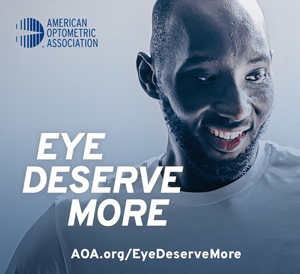Save Your Vision Month Is Here as ODs Remind Patients to Prioritize Their Eyes in 2022
March is optometry's time. It is when doctors of optometry celebrate Save Your Vision Month, which traces its founding to 1927 by members of the American Optometric Association. The annual public health observance is happening just before a new phase of the AOA’s Eye Deserve More campaign kicks off this spring, but optometrists don’t have to wait to participate. Read more about the Eye Deserve More campaign here.
Save Your Vision Month reaffirms how doctors of optometry, America’s primary eye health and vision care providers, deliver essential health care that goes beyond a vision correction prescription and should be a critical component of patients’ preventive health regimen. This month—and year-round—the AOA is reminding patients to prioritize their eye health and vision care in 2022 by scheduling their families’ in-person, comprehensive eye exams.

|
|
|
|
The annual public health observance will kick off a new phase of the AOA’s Eye Deserve More campaign this spring, building on an impactful 2021. More thorough examinations. More expert analysis. More personalized care than you could ever get with an“online vision test”—that’s the message of Eye Deserve More, the AOA said. And that’s what you can expect from an in-person comprehensive eye exam from and AOA doctor of optometry. From pro athletes to everyday people, everyone deserves more when it comes to their eye health.
Since April 2021, the AOA’s Eye Deserve More campaign has earned more than 3.6 billion impressions and 3,000 media placements in national and local news outlets; generated 26 million impressions on social media and 91,000 clicks on the AOA’s doctor locator; and amplified its message with partnerships between USA Surfing’s Caroline Marks, pro-basketball player Tacko Fall and their AOA doctors. To see the the impact of the Eye Deserve More campaign click here. Increasing screen time and the popularity of gaming opens an opportunity for the profession to demonstrate how regular optometric care can help keep patients’ eyes healthy. To help amplify these efforts, the AOA will provide a suite of customizable materials and resources, as well as communications materials to utilize over the course of the year.
The Save Your Vision Month campaign officially launches in spring 2022, but the AOA is encouraging ODs to get involved now: ODs can spread the importance of Save Your Vision Month by sharing posts from AOA’s social media calendar on their social channels.
Share a patient testimonial that helps the AOA tell the story of optometry’s essential care. Learn more about collecting patient testimonials or read those that have been shared already.
|